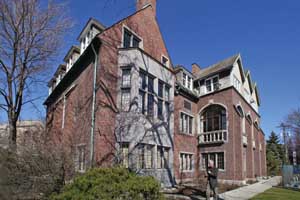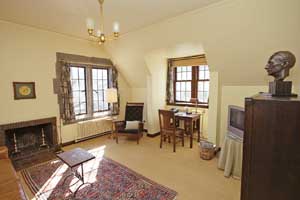An architectural treasure is linked to University’s intellectual riches
By Peter SchulerNews Office
 The University’s Quadrangle Club, designed by Howard Van Doren Shaw and built in 1922, will benefit from the proceeds of the Quadrangle Club Preservation Ball. The fund-raiser supports the building’s $5 million restoration project. |
 The Quadrangle Club, which accommodates guests in its 21 sleeping rooms, includes the restored room shown above. This suite was named the Howard Van Doren Shaw Suite, after the building’s architect. |
It is likely more than a few great ideas coming out of the University were conceived over the past 100 years by faculty members lunching at the Quadrangle Club.
Ever since the University’s first president William Rainey Harper and other faculty members decided in 1894—two years after the University’s founding—that “the University must have a club,” as one early member put it, the rich histories of the Quadrangle Club and the University have been intertwined.
The Quadrangle Club’s Fourth Annual Preservation Ball on Saturday, May 1, celebrates the club’s continuing ties to the University and Hyde Park and supports a $5 million restoration of the landmark clubhouse at the corner of 57th Street and University Avenue. Built in 1922 and designed by noted Chicago architect Howard Van Doren Shaw, the Quadrangle Club—and the land on which it sits—is owned by the University. The club’s lease expires in 2016.
The Preservation Ball was launched in 2001, and the event sells out each year. Quadrangle Club member Ted Cohen, Professor in Philosophy and the College, his wife Andy Austin Cohen and other club members created the annual fund-raiser, which welcomes more than 200 guests for an evening of dining and dancing. A noted Chicago musical group, the Bradley Young Orchestra, will entertain guests at this event, which runs from 6 p.m. to midnight.
Cohen called the club “a priceless building” that “serves the University in many ways, besides being the locus for a number of community activities.” While the Quadrangle Club bylaws mandate that a percentage of members and officers be University faculty or staff, Cohen pointed out that membership is not restricted to University faculty and staff and that “it is extremely important to us that it become even more of a community institution.”
Leon Despres (Ph.B.,’27, J.D.,’29) and his wife Marian Alschuler Despres (Ph.B.,’30, Ph.D.,’36) are honorary chairs of the Preservation Ball. Leon Despres is a Hyde Park attorney and a legendary independent alderman, who represented the neighborhood in the City Council from 1955 to 1975 when Richard J. Daley was Mayor.
He led the establishment of the Chicago Commission on Architectural Landmarks and the passage of its first fair housing ordinance. He also was a founder of the Hyde Park Historical Society, among countless other civic contributions. His wife, Marian, has been a lifelong advocate for architectural preservation.
“Our board and many of the club’s leading supporters share a vision that the Quadrangle Club is perhaps one of the best investments we can make toward the vitality of Hyde Park,” said Todd Schwebel, (X.,’86), a board member who is the head of a nationally recognized architecture and design firm in Chicago and one of the leaders of the Quadrangle Club restoration project, along with club president Michael Rosen.
“This effort is much more than bricks and mortar,” Schwebel said. “We want to reinvigorate the club as a wonderful venue where people of all ages can gather for civic and social events, relax, share ideas and make new friends. And we all have been gratified to see the relationship between the University and the club growing stronger, inspired by numerous leadership gifts from University trustees, senior staff and faculty, and community leaders who support the club and who understand its great potential as a positive force in our community.”
Schwebel said the clubhouse building is “a superb example of Shaw’s design at its best. And what is particularly exciting is that it is almost entirely intact, down to the interior masonry and architectural details. It’s an extraordinarily important preservation of his work.
“Shaw modeled the building,” Schwebel explained, “after an English country house, with large, airy spaces for dining, play, sitting and sleeping, and with the focus on its southern exposure.” Shaw intended the entire building to be flooded with as much light as possible so the open space created by its tennis courts was an integral part of his design. Schwebel noted that even the dormered sleeping rooms on the third floor receive abundant daytime light. The exterior red brick, the slate roof and other features were chosen to create a subtle, pleasing transition between the neo-Gothic quadrangle across the street and its residential neighbors.
The Quadrangle Club jointly sponsors the Preservation Ball with the Howard Van Doren Shaw Society, of which Schwebel is president, a group that honors the memory of this Chicago architect. Shaw, who was born and raised in Hyde Park, was one of the pre-eminent country house architects at the turn of the 19th century. He built 21 large homes in the Hyde Park and Kenwood neighborhoods and almost as many in Lake Forest, Ill., a favorite summer retreat for the wealthiest Chicagoans, many of whom lived on the mid-South Side.
Shaw also designed notable Chicago buildings, including the Lakeside Press Building, the Fourth Presbyterian Church and the Goodman Memorial Theatre, as well as Market Square in Lake Forest.
Shaw had been chosen to restore an earlier clubhouse after it was damaged by fire. That building, which was located where the Oriental Institute now stands, was moved two blocks west and became Ingleside Hall, which still stands. “That was only one reason Shaw was a natural choice to build the new clubhouse,” Schwebel said. “In 1922, he was at the height of his career, and he was well known to the leading figures in the city at the time, many of whom were his friends.”
The restoration of the Quadrangle Club has included extensive work to ensure its structural integrity, and repair and restoration of the slate roof and its distinctive copper ornamentation. In addition, the club’s bar has been restored to what Shaw originally intended and has become very popular, particularly on Friday evenings when jazz is played.
The 21 sleeping rooms and suites are being methodically refurbished in period style, which began with one of the largest suites, now named the “Howard Van Doren Shaw Suite.” The tax-deductible contributions for this year’s ball will underwrite the renovation of the “William Rainey Harper Suite.”
“It’s an incredible building—inviting and beautiful,” said Ruth O’Brien (A.B., ’83), who is on the staff of the Physical Sciences Division and is the ball’s co-chair. “What we’re doing now is bringing the club back to the treasure that Shaw created, which makes it just that much easier for the club to be an even stronger link between our University and our neighborhood.”
Please contact the Quadrangle Club at (773) 702-2550 for further information.
![[Chronicle]](/images/sidebar_header_oct06.gif)